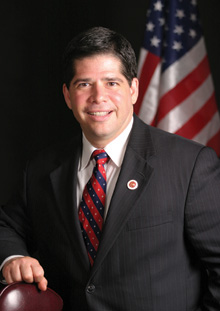
Council Member Vincent Gentile is working to stop illegal home conversions in New York City. Image Credit: Office of Councl Member Vincent J. Gentile
Pending legislation would make it easier to impose civil penalties for illegal conversions. In recent months, City Council Member Vincent Gentile has introduced two bills to address the issue of illegal home conversions in New York City. According to Ann Falutico, Zoning Committee Chair for Brooklyn Community Board 10, a study of 311 statistics show that since 2010, over 1,000 complaints for illegal home conversions came from communities within the Council Member’s district, Bay Ridge, Dyker Heights, and Fort Hamilton.
An illegal home conversion occurs when a property owner extensively renovates a building to house multiple families without the necessary Department of Buildings permits. Justin Brannan, from Council Member Gentile’s office, said “Illegal conversions pose a hazard to tenants, with faulty wiring that can cause fires or excavated basements weakening building foundations and risking collapse.” Mr. Brannan also stated that complaints made to the Council Member’s office largely came from Dyker Heights, a neighborhood of one- and two-family homes instead of tall apartment buildings or warehouse lofts. Since speaking out on the issue, the Council Member has learned that illegal conversion complaints are prevalent in similar neighborhoods elsewhere in the city, requiring a citywide response.
Illegal conversions have also been attacked for the ripple effects on the community at large. On July 24, 2014 CB 10’s District Manager Josephine Beckmann said “Illegal conversions are quickly increasing the density of our community, greatly impacting public services.” City resources such as water, sewage, sanitation, first responders, and even public schools are allocated to a community based on how many people for whom the community is zoned. Illegal conversions increase the number of people consuming those resources beyond what was intended, diminishing availability for everyone. District Manager Beckmann spoke with CityLand and emphasized that the sewer system is over one hundred years old, and that even with two new schools built in the last decade, there is still overcrowding. “Our concern is that as these one- and two-family homes are illegally converted, at some point, it’s just not going to be sustainable.” Community Board 10 began working on this issue last spring after meeting with the Brooklyn Housing Preservation Alliance. Community Board 10‘s zoning committee met throughout the summer and continues to discuss ways to correct this problem not only at the enforcement stage, but also earlier in the conversion process. District Manager Beckmann told CityLand that the Board expects to have final recommendations by the end of this year and intend to work with city agencies to assure their viability.
On June 26, 2014, Council Member Gentile introduced Intro 393 which would grant any law enforcement entity the power to issue a summons or notice of violation for an illegal conversion, and the summons or violation can be written based upon “readily observable circumstantial evidence” including the presence of mailboxes, operational utility meters, or doorbells servicing a dwelling than there are in excess of the authorized residential units in the dwelling. Currently a violation may only be issued after a Buildings inspector enters the building with the property owner’s permission, and if an inspector fails to gain entry after three attempts, the complaint is closed.
On August 21, 2014, the Council Member introduced Intro 439 to expand sanctions on registered design professionals that submit incorrect certified applications for construction permits. The bill would allow the Department of Buildings Commissioner to impose existing sanctions on any registered design professional who, within a 12-month period, submits two professionally-certified applications for a construction permit with errors that result in a stop work order. Brannan stated that the bill is intended to punish licensed professionals that habitually illegally convert buildings through self-certifying false building plans.
Council Member Gentile told CityLand that his office continues to develop legislative solutions to the problem, and is currently looking to permit Buildings inspectors to access the work site of a suspected illegal conversion both during construction and up to six months after work is completed. “The biggest problem we have is that we can’t certify a building is an illegal conversion until after someone moves in.” According to the Council Member, Intro. 393 and Intro. 439 do not yet have hearing dates as they are still in an “educational period”, saying “Some people think we’re targeting Grandma renting out her basement, when that’s not the problem. The problem is these organized, institutionalized actors that come in and buy up properties with the intention of illegally converting them to house as many people as possible and maximize their investment.”
The Council Member went on to tie illegal home conversions to New York City’s affordable housing shortage, stating that homes which should cost a new family in the hundreds of thousands are instead bought by institutionalized illegal converters for millions, forcing families out of the neighborhood. “This is a rapidly growing issue around New York City’s neighborhoods, affecting quality of life and our affordable housing stock, and can drive out portions of our tax base if not stopped.”
City Council: Int 0393-2014 (Jun. 26, 2014), Int 0439-2014 (Aug. 21, 2014).
By: Michael Twomey (Michael is a CityLaw Fellow and a New York Law School Graduate, Class of 2014)


In the article it states that the DOB will close out a case after 3 failed attempts to gain access to a building. It should state “…after 2 failed attempts…”